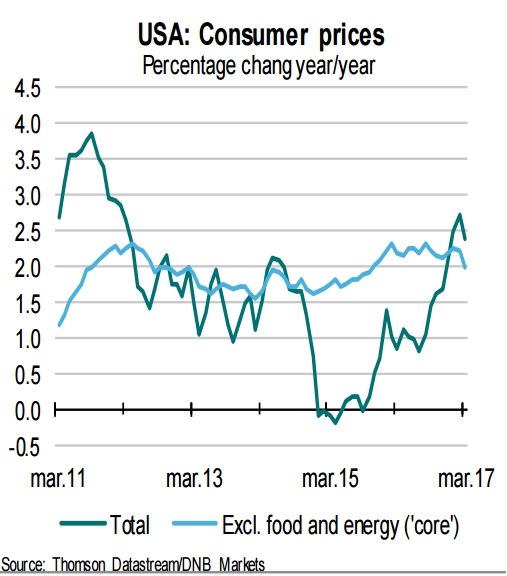A report by the Labor Department on Friday last week showed U.S. Consumer Price Index dropped 0.3 percent in March, the first decline since February 2016. March US CPI inflation was much weaker than expectations for an unchanged reading. Declining costs for gasoline and mobile phone services offset rising rents and food prices. However, analysts feel several of the declines in March appear outsized and are likely to be reversed.
The core CPI, which strips out food and energy costs, declined 0.1 percent, the first and largest decrease since January 2010, after rising 0.2 percent in February. A 6.2 percent drop in gasoline prices was the biggest factor in the monthly decline in the CPI. Monthly consumer inflation was also weighed down by a record 7.0 percent drop in the cost of wireless telephone services.
Market expectations of a rise in interest rates at the Fed’s June meeting have fallen to about 50 percent, from more than 60 percent a week ago. Analysts feel the inflation miss was mainly due to temporary factors, and with the annual trend in the Consumer Price Index being still upward, should not worry the Fed too much. The monthly decline could likely reinforce the Federal Reserve’s plan for a gradual rise in interest rates.
"Some Fed officials will be disturbed by the unexpected drop back in core inflation, but this won't prevent a June rate hike," said Paul Ashworth, chief U.S. economist at Capital Economics in Toronto.
Consumer confidence remains elevated, indicating a pick-up in consumption growth. In particular, the current conditions rose to a 16-year high and is traditionally well correlated with labour market developments. Initial claims dropped by 1k to 234k last week. The trend has stabilized in the past few weeks and is consistent with high employment growth. GDP numbers which are scheduled to be released on April 28 will be in focus for impact on investor sentiment.
Dampened expectations of a faster Fed rate-tightening cycle coupled with the ongoing downslide in the US treasury yields further undermined the US Dollar demand. DXY was down 0.28 percent trading at 100.02 at 1130 GMT. At the same time, FxWirePro's Hourly USD Spot Index was at -69.4983 (Slightly bearish). For more details on FxWirePro's Currency Strength Index, visit http://www.fxwirepro.com/currencyindex.



 Interest rates: Monetary policy is always political as central banks opt to back the financial sector
Interest rates: Monetary policy is always political as central banks opt to back the financial sector  After Iran’s attack on Israel, is a devastating regional war next?
After Iran’s attack on Israel, is a devastating regional war next?  Sure, the RBA froze interest rates on Tuesday, but there's plenty of pain to come
Sure, the RBA froze interest rates on Tuesday, but there's plenty of pain to come  The rising flood of space junk is a risk to us on Earth – and governments are on the hook
The rising flood of space junk is a risk to us on Earth – and governments are on the hook  RBA's latest forecasts are grim. Here are 5 reasons why
RBA's latest forecasts are grim. Here are 5 reasons why  Governments have been able to overrule the Reserve Bank for 80 years. Why stop now?
Governments have been able to overrule the Reserve Bank for 80 years. Why stop now?  What central banks are doing to safeguard financial stability and why they must proceed with caution
What central banks are doing to safeguard financial stability and why they must proceed with caution  In a time of information overload, enigmatic philosopher Byung-Chul Han seeks the re-enchantment of the world
In a time of information overload, enigmatic philosopher Byung-Chul Han seeks the re-enchantment of the world  Video games at work? It sounds fun, but there are ethical risks
Video games at work? It sounds fun, but there are ethical risks  As treasurer, Bill Hayden set Labor on the path to economic rationalism
As treasurer, Bill Hayden set Labor on the path to economic rationalism  The RBA has kept interest rates on hold. Here's why it'll be cautious from here on
The RBA has kept interest rates on hold. Here's why it'll be cautious from here on  Rogue waves in the ocean are much more common than anyone suspected, says new study
Rogue waves in the ocean are much more common than anyone suspected, says new study  Inflation: I've been analysing the Bank of England's forecast over the past two years – here's how they got it wrong
Inflation: I've been analysing the Bank of England's forecast over the past two years – here's how they got it wrong  ‘They don’t have enough’ – schools in England are running food banks for families
‘They don’t have enough’ – schools in England are running food banks for families 





























